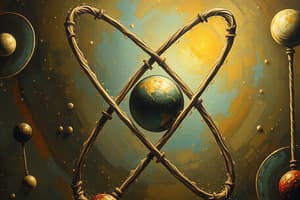Podcast
Questions and Answers
What sub-atomic particle has a relative mass of 0 and a relative charge of -1?
What sub-atomic particle has a relative mass of 0 and a relative charge of -1?
- Isotope
- Electron (correct)
- Neutron
- Proton
Which sub-atomic particle is responsible for the identity of an element?
Which sub-atomic particle is responsible for the identity of an element?
- Electron
- Neutron
- Proton (correct)
- Isotope
What term is used for atoms of the same element that contain a different number of neutrons?
What term is used for atoms of the same element that contain a different number of neutrons?
- Ions
- Molecules
- Isotopes (correct)
- Relative masses
Which term is used for atoms of the same element that contain a different number of protons or electrons?
Which term is used for atoms of the same element that contain a different number of protons or electrons?
What is the average mass of an atom of an element compared to 1/12th the mass of an atom of carbon-12 called?
What is the average mass of an atom of an element compared to 1/12th the mass of an atom of carbon-12 called?
Which instrument can be used to find the masses of different isotopes?
Which instrument can be used to find the masses of different isotopes?
What is the mass of an atom of an isotope of an element compared to 1/12th the mass of an atom of carbon-12 called?
What is the mass of an atom of an isotope of an element compared to 1/12th the mass of an atom of carbon-12 called?
What is the average mass of a molecule compared to 1/12th the mass of an atom of carbon-12 called?
What is the average mass of a molecule compared to 1/12th the mass of an atom of carbon-12 called?
What type of atoms have a different number of protons or electrons?
What type of atoms have a different number of protons or electrons?
What term describes atoms containing a different number of neutrons?
What term describes atoms containing a different number of neutrons?
What is the relative atomic mass of carbon?
What is the relative atomic mass of carbon?
What is the Relative Molecular Mass (Mr) of Water, H2O?
What is the Relative Molecular Mass (Mr) of Water, H2O?
What is the Maximum number of electrons that can be present in the 3rd shell (n = 3)?
What is the Maximum number of electrons that can be present in the 3rd shell (n = 3)?
What is the Principal Quantum Number for the 4th shell (n = 4)?
What is the Principal Quantum Number for the 4th shell (n = 4)?
What is the Relative Molecular Mass (Mr) of Carbon Dioxide, CO2?
What is the Relative Molecular Mass (Mr) of Carbon Dioxide, CO2?
What is the Principal Quantum Number for the 1st shell (n = 1)?
What is the Principal Quantum Number for the 1st shell (n = 1)?
What is the Relative Molecular Mass (Mr) of Ethanol, CH3CH2OH?
What is the Relative Molecular Mass (Mr) of Ethanol, CH3CH2OH?
What is the angular momentum quantum number, l, for the 2nd shell (n = 2)?
What is the angular momentum quantum number, l, for the 2nd shell (n = 2)?
What is the Relative Molecular Mass (Mr) of Acetone, CH3COCH3?
What is the Relative Molecular Mass (Mr) of Acetone, CH3COCH3?
What is the range of magnetic moment numbers (ml) for the 3rd shell (n = 3)?
What is the range of magnetic moment numbers (ml) for the 3rd shell (n = 3)?
Flashcards are hidden until you start studying




